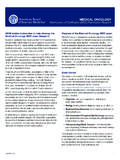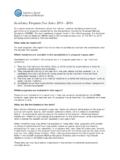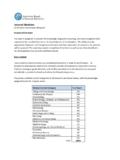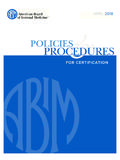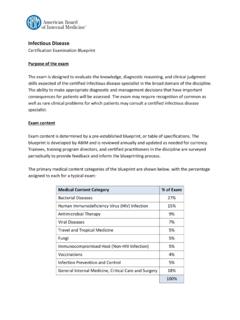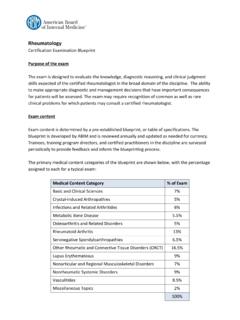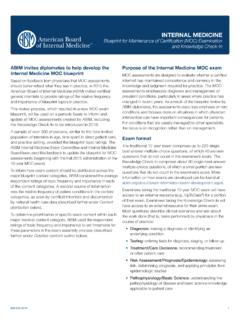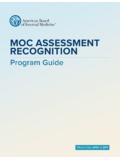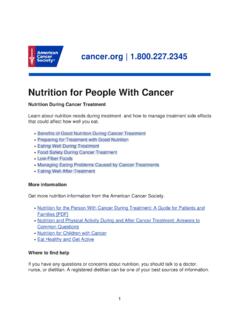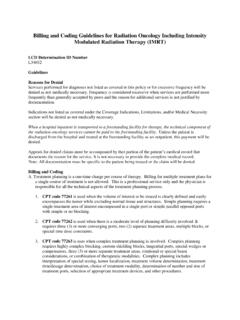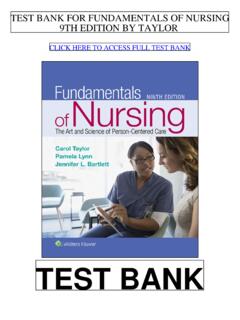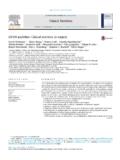Transcription of INTERNAL MEDICINE
1 JANUARY 20221 ABIM invites diplomates to help develop the INTERNAL MEDICINE MOC blueprintBased on feedback from physicians that MOC assessments should better reflect what they see in practice, in 2015 the American Board of INTERNAL MEDICINE (ABIM) invited certified general internists to provide ratings of the relative frequency and importance of blueprint topics in review process, which resulted in a new MOC exam blueprint , will be used on a periodic basis to inform and update all MOC assessments created by ABIM. No matter what form ABIM s assessments ultimately take, they will need to be informed by front-line clinicians sharing their perspective on what is important to sample of over 300 physicians, similar to the total invited population of internists in age, time spent in direct patient care, and practice setting, provided the blueprint topic ratings.
2 ABIM used this feedback to update the blueprint for MOC assessments (beginning with the Fall 2015 administration of the traditional, 10-year MOC exam).To inform how assessment content should be distributed across the major blueprint content categories, ABIM considered the average respondent ratings of topic frequency and importance in each of the content categories. A second source of information was the relative frequency of patient conditions in the content categories, as seen by certified Internists and documented by national health care data (described further under Content distribution below).To determine prioritization of specific exam content within each major medical content category, ABIM used the respondent ratings of topic frequency and importance to set thresholds for these parameters in the exam assembly process (described further under Detailed content outline below).
3 Purpose of the INTERNAL MEDICINE MOC AssessmentsMOC assessments are designed to evaluate whether a certified internist has maintained competence and currency in the knowledge and judgment required for practice. The MOC assessments emphasizes diagnosis and management of prevalent conditions, particularly in areas where practice has changed in recent years. As a result of the blueprint review by ABIM diplomates, the assessments place less emphasis on rare conditions and focuses more on situations in which physician intervention can have important consequences for patients. For conditions that are usually managed by other specialists, the focus is on recognition rather than on formatThe traditional, 10-year MOC exam comprises up to 220 single- best-answer multiple-choice questions, of which approximately 50 are new questions that do not count in the examinee s score.
4 Examinees taking the MOC exam will have access to an external resource ( , UpToDate ) for the entire exam. The LKA for MOC is a five-year cycle in which physicians answer questions on an ongoing basis and receive feedback on how they re performing along the way. More information on how assessments are developed can be found at questions describe clinical scenarios and ask about the work done (that is, tasks performed) by physicians in the course of practice: Diagnosis: making a diagnosis or identifying an underlying condition Testing: ordering tests for diagnosis, staging, or follow-up Treatment/Care Decisions: recommending treatment or other patient care Risk Assessment/Prognosis/Epidemiology: assessing risk, determining prognosis, and applying principles from epidemiologic studies Pathophysiology/Basic Science.
5 Understanding the pathophysiology of disease and basic science knowledge applicable to patient careINTERNAL MEDICINE BlueprintFor traditional, 10-year Maintenance of Certification (MOC) exam and Longitudinal Knowledge Assessment (LKA )JANUARY 20222 Reflecting the overall predominance of office-based INTERNAL MEDICINE practice, most questions describe patient encounters that take place in outpatient settings; some encounters will occur in hospital or other inpatient settings as most general internists provide patient care in these settings as information presented may include patient photographs, radiographs, electrocardiograms, and other media to illustrate relevant patient tutorials, including examples of ABIM assessment question format, can be found at distributionListed below are the major medical content categories that define the domain for the INTERNAL MEDICINE traditional, 10-year MOC exam and LKA.
6 The relative distribution of content is expressed as a percentage of the total assessment. To determine the content distribution, ABIM considered the average respondent ratings of topic frequency and importanceTo cross-validate these self-reported ratings, ABIM also considered the relative frequency of conditions seen in patients from the National Ambulatory Medical Care Survey (NAMCS) and the National Hospital Discharge Survey (NHDS) by a cohort of certified internists. Informed by these data, the INTERNAL MEDICINE Approval Committee and INTERNAL MEDICINE Board have established the content category INTERNAL MEDICINE MOC assessments may cover other dimensions of MEDICINE as applicable to the medical content categories, such as critical care MEDICINE , preventive MEDICINE , women s health, clinical epidemiology, ethics, nutrition , palliative and end-of-life care, occupational MEDICINE , patient safety.
7 And substance use the blueprint ratings are used to assemble the MOC assessments blueprint reviewers provided ratings of relative frequency in practice for each of the detailed content topics in the blueprint and provided ratings of the relative importance of the topics for each of the tasks described in Assessment format above. In rating importance, reviewers were asked to consider factors such as the following: High risk of a significant adverse outcome Cost of care and stewardship of resources Common errors in diagnosis or management Effect on population health Effect on quality of life When failure to intervene by the physician deprives a patient of significant benefitFrequency and importance were rated on a three-point scale corresponding to low, medium, or high.
8 The median importance ratings are reflected in the Detailed content outline below. The INTERNAL MEDICINE Approval Committee and INTERNAL MEDICINE Board, in partnership with the physician community, have set the following parameters for selecting MOC assessment questions according to the blueprint review ratings: At least 75% of questions will address high-importance content (indicated in green) No more than 25% of questions will address medium- importance content (indicated in yellow) No questions will address low-importance content (indicated in red)Independent of the importance and task ratings, no more than 18% of questions will address low-frequency content (indicated by LF following the topic description).
9 MEDICAL CONTENT CATEGORYT arget %Allergy and Immunology2%Cardiovascular15%Dermatology 3%Endocrinology, Diabetes, and Metabolism10%Gastroenterology10%Geriatri c Syndromes3%Hematology4%Infectious Disease10%Medical Oncology6%Miscellaneous1%Nephrology and Urology6%Neurology4%Obstetrics and Gynecology3%Ophthalmology1%Otolaryngolog y and Dental Medicine1%Psychiatry3%Pulmonary Disease8%Rheumatology and Orthopedics10%Total100%JANUARY 20223 ALLERGY AND IMMUNOLOGY(2% of exam)DiagnosisTestingTreatment/ Care DecisionsRisk Assessment/ Prognosis/ EpidemiologyPathophysiology/ Basic ScienceANAPHYLAXIS (<2% of exam)Aspirin idiosyncrasyLFStinging insect hypersensitivityDesensitization therapyLFSerum sickness*Undifferentiated anaphylaxis*ASTHMA (<2% of exam)Exercise- and cold-induced asthmaAllergic bronchopulmonary aspergillosisLFNasal polyps and aspirin sensitivityOccupational asthmaAsthma and pregnancyLFAsthma mimics (including vocal cord dysfunction)LFUndifferentiated asthmaRHINITIS/SINUSITIS/CONJUNCTIVITIS (<2% of exam)Allergic rhinitisAcute and chronic sinusitisAllergic conjunctivitisUpper airway cough syndromeDetailed Content Outline for the INTERNAL MEDICINE traditional, 10-year MOC exam and the LKA High Importance.
10 At least 75% of questions will address topics and tasks with this designation. Medium Importance: No more than 25% of questions will address topics and tasks with this designation. Low Importance: No questions will address topics and tasks with this Low Frequency: No more than 18% of questions will address topics with this designation, regardless of task or content selection priorities below are subject to change in response to future blueprint : The same topic may appear in more than one medical content category.*This topic was added or revised after the blueprint was reviewed by INTERNAL MEDICINE diplomates; it has been provisionally rated by the INTERNAL MEDICINE Approval Committee, pending the next blueprint review 20224*This topic was added or revised after the blueprint was reviewed by INTERNAL MEDICINE diplomates; it has been provisionally rated by the INTERNAL MEDICINE Approval Committee, pending the next blueprint review process.
